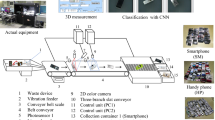Abstract
Recycling of clothes is a straightforward approach for the supply of a coloured raw material which does not involve the cost of the colouring process. A real time and completely automated colour classification tool for woollen clothes to be recycled is proposed. The tool uses the combination of a statistical method, called matrix approach, of a self-organizing feature map (SOFM) and a feed-forward backpropagation artificial neural network (FFBP ANN)-based approach, to correctly classify the clothes by respecting the selection criteria provided by human know-how. The developed tool, which uses an appositely developed workbench with a spectrophotometer, is aware of the way the different coloured clothes to be recycled combine each other to create a new one. The tool has been validated using a set of 5,000 differently coloured clothes to be recycled and the classification error in classifying the clothes is within 5%, i.e., lower than the one resulting from the use of an expert human operator.
Similar content being viewed by others
References
Barnard K, Martin L, Funt BV (2000) Colour by correlation in a three dimensional colour space. 6th European Conference on Computer Vision 2000 pp 275–289
Pérez E, Millán MS (1997) Adaptive channel selection for improving chromatic discrimination in colour pattern recognition. Opt Commun 134(1–6): Elsevier Science BV, 273–280
Luo MR (2006) Applying colour science in colour design, Optics & Laser Technology,38 (4–6). Colour and Design in the natural and man-made worlds. 392–398
Pellerin C (1997) Machine vision in experimental poultry inspection. NDT & E International 30(5): Elsevier Science BV 331
Rich DC, Martin D (1999) Improved model for improving the inter-instrument agreement of spectrocolorimeters. Analytica Chimica Acta 380(2–3): 263–276
Cheng HD, Jiang XH, Sun Y, Wang J (2001) Color image segmentation: advances and prospects. Pattern Recognition 34(12) 2259–2281
Sangole A, Knopf GK (2003) Visualization of randomly ordered numeric data sets using spherical self-organizing feature maps. Computers & Graphics 27(6) 963–976
Bishop CM (1995) Neural Networks for Pattern Recognition. New York: Oxford University Press Inc
Waszczyszyn Z (1999) Introduction to Artificial Neural Networks and their applications in structural engineering. Lectures delivered at the Civil Engineering Faculty, University of Florence, Italy
Kohonen T (1987) Self-Organization and Associative Memory. Springer, Berlin Heidelberg New York
Marsland S, Shapiro J, Nehmzow U (2002) A self-organising network that grows when required. Neural Networks 15(8–9) 1041–1058
Basheer IA, Hajmeer M (2000) Artificial neural networks: fundamentals, computing, design, and application. J Microbiol Methods 43(1) 3–31
Egmont-Petersen M, Ridder D, Handels H (2002) Image processing with neural networks-a review. Pattern Recognition 35(10) 2279–2301
Ripley BD (1996) Pattern Recognition and Neural Network. Cambridge: Cambridge University Press
Papadokonstantakis S, Lygeros A, Jacobsson SP (2006) Comparison of recent methods for inference of variable influence in neural networks. Neural Networks 19(4) 500–513
Davis P (1993) Levenberg-Marquart Methods and Nonlinear Estimation. SIAM News 26(6)
Author information
Authors and Affiliations
Corresponding author
Rights and permissions
About this article
Cite this article
Furferi, R., Governi, L. The recycling of wool clothes: an artificial neural network colour classification tool. Int J Adv Manuf Technol 37, 722–731 (2008). https://doi.org/10.1007/s00170-007-1011-2
Received:
Accepted:
Published:
Issue Date:
DOI: https://doi.org/10.1007/s00170-007-1011-2




